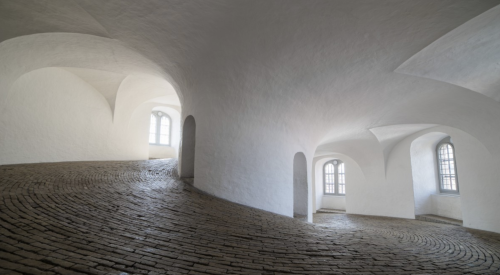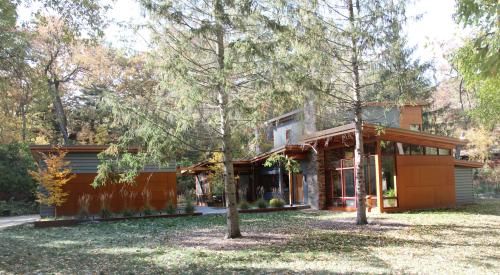| Because no load-bearing walls were needed on the interior of this home, the floor plan is open and dramatic. Walls and columns were placed for aesthetic purposes only.
|
WeÆve all seen real estate listings that advertise "contractorÆs own" homes as if they were intrinsically better than those built for clients. That holds some truth, as nearly everyone is more exacting when they are building something for themselves. But that seldom tells the whole story.
Commercial Builder Gary Shaw and his wife are no different. Recently empty nesters, they wanted to build their retirement home and wanted it to suit their tastes exactly. They also wanted a bit more.
"We wanted to do most of the interior work ourselves, pay as we go and move in with a clear mortgage," says Shaw. "We needed a weather-tight structure built fairly quickly so we could whittle away at the interior on our nights and weekends."
Shaw then turned to what he knew, which was building with metal. As vice president of Quinlan Construction, Inc. of Boulder, Colo., Shaw has worked extensively with metal and saw a way to make it work for his own residential needs. He contracted American Buildings Company (one of the companies Quinlan uses in its commercial ventures) to erect the steel framework and dry everything in a matter of days. He and his wife Linda then spent the next 18 months finishing the inside.
| With parapets, exposed wooden beams and an adobe-style siding material, one would never guess that this house was constructed with a commercial steel frame.
|
Building with metal not only allowed the Shaws time, it also allowed them nearly limitless interior design freedom. Because it is a clear-span structure with no interior columns, the Shaws were able to turn their interior designer loose to do as he pleased.
"Gary came to me and said that he had a metal building that he wanted to finish in a Santa Fe style, but other than that I could do whatever I wanted," says Randall Hartman of Randall J. Hartman Architects in Boulder.
Hartman had to place the bathroom and kitchen in certain areas because of the plumbing under the slab, but was otherwise free to flex his design muscles.
"When I got there, it was almost like an airplane hangar where I could build a playhouse inside," says Hartman. "I could place rooms as I pleased, and vary the ceiling heights throughout, which is really neat."
| Floor plan
|
The result is a warm, open floor plan that belies its metal shell. The home opens into a small foyer with a nine-foot ceiling, and then flows into an expansive plan separated by a fireplace wall and stepped boncos (a Santa Fe term for kneewalls). The two bedrooms, bonus exercise room and bathrooms are the only rooms enclosed in the entire home.
To truly capture the effect of Santa Fe architecture, Shaw used 2 X 6 framing nearly two feet in from the metal exterior walls. Once the windows and doors were set and the interior finishes applied, the walls appeared to be authentic two-foot thick adobe. The resulting air space between the interior walls and the metal shell also provides an extra measure of insulation, which was already measured at R-38.
The exterior of the home had to be kept simple, because as Shaw explains, "Metal buildings donÆt like too many ins and outs or height changes. There is too much flashing involved to make it practical."
| Exterior
|
Shaw used EIFS (exterior insulating and finishing systems) for siding material. He was aware of the moisture problems that have been associated with EIFS in some areas of the country, but was confident he would have no such problems.
"We used corrugated tin siding on the metal shell, then applied the EIFS directly to that," says Shaw. "The spaces provided by the tin acted as air channels, and our dry climate here in the mountains made moisture infiltration a non-issue. Plus, the tin wonÆt rot as a typical wood substrate will, which is where most of the EIFS problems manifest themselves."
Shaw says that his metal exterior structure is about 15% more expensive than stick framing, but he made up for some of that added cost by saving on wood framing on the interior. The home cost him $325,000 to build, or about $68 per square foot.
"The economics of this type of structure are such that it would not be widely applicable to other homes," says Hartman. "Gary had the unique resources, know-how and ambition to make this work well for him."
| By stick-framing another wall nearly two feet inside the metal shell, builder/homeowner Gary Shaw ended up with authentic adobe-looking walls.
|
Shaw installed marble and tile countertops and ceramic tile floors, and an in-floor hot water heating system. He also put in an evaporative cooler instead of a traditional air-conditioning unit. These units, also known as swamp coolers, run water over filters, and a fan draws air over those filters into the house. This cools the home while regulating the interior humidity.
"ItÆs the most energy-efficient cooler you can get," says Shaw. "The only electricity needed is that to power a 110-volt fan unit. There are no condensers, which is what eats up the kilowatts on a typical HVAC unit."
The 3000-square-foot home sits on five acres of beautiful mountain range land, and also includes two 480-square-foot porches and 1800 square feet of unconditioned garage and shop space. The methods employed to erect this home are so unique that American Buildings Company awarded Shaw with a "1999 Design/Build Award."
So with ingenuity, ambition and a great team behind them, the Shaws were able to move into their dream retirement home in December of 1999.
"Our kids have been gone for a while," says Shaw, "but they do seem to be coming back more often now that weÆve moved in here."











